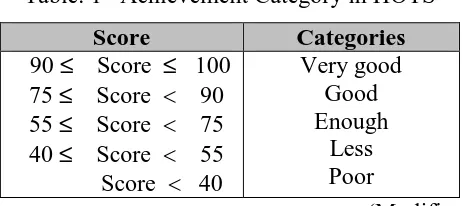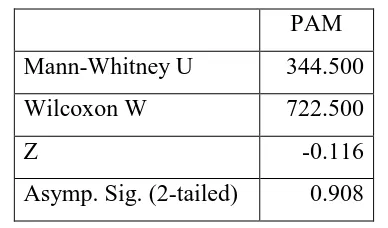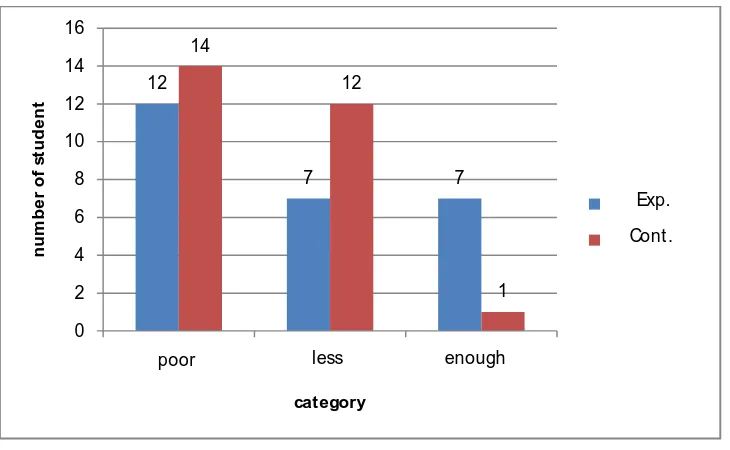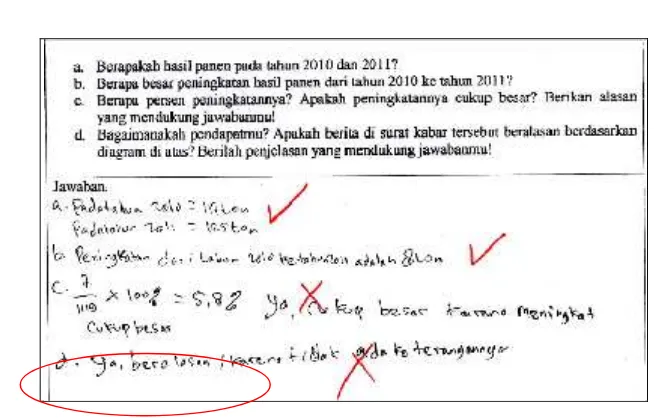The Influence of Computer-Assisted Realistic Mathematics Education onStudents’Higher Order Thinking Skills
Ely Susanti ( SPs Graduate UPI ) Yaya S Kusumah ( UPI )
Abstract
Article Info ABSTRACT
This research is aimed to investigate the influence of computer assisted realistic mathematics education on higher order thinking skills. Sample in this research are high school student in Palembang with higher shool level. This is experimental research. The instrument is used a test item for higher order thinking skills. Data analysis used parametric statistics. The results indicated that there is no influence of computer assisted realistic mathematics education on students' higher order thinking skills. Implications of the results were discussed and suggestions were students must have skills in using computer before learning with computer assisted realistic mathematics education.
Keyword : Computer assisted
Keyword : realistic mathematics education Keyword : higher order thinking skills
Corresponding Author Name : Ely Susanti
Affiliation : Student in UPI
Address : Jln Pangeran Ayin Komp Sako Garden 2 Blok D.16 Kel Sako Kec Sako Palembang
Phone: 081367717886
Email: ely_pasca@yahoo.com 1. INTRODUCTION
to acquire, to manage, to analyze, to synthesize and to use the information to achieve the goal or to find a settlement of a situation (problem) is difficult.
Based on the above obtained a description of the relationship between a person's ability to think and the ability to survive when faced with a challenge. The better a person's ability to think critically, the better the ability to solve the problems encountered and the greater the potential to survive and win in competitions such as global competition, due to higher-order thinking skills are better then the greater the potential for someone to make good problem solver.
Previous research suggests there are several learning activities that can improve students' higher-order thinking skills, such as: technology-enriched environment (Handa, 2000) and (Hapson, 2002), (2) computer-assisted learning (Cotton , 1991), (3) learning in small groups, peer tutoring, cooperative, collaborative (Tobin, Capie and Bettencourt, 1988), (4) books (teaching materials) and additional guidances is more emphasis on the activities of information gathering, remembering, and organizing skills (Shepardson, 1993), (5) inquiry learning (Haugh, 2002), (6) Scaffolding (Slavin, 1995).
One study that assessed in accordance with literature above is computer-assisted realistic mathematics education, so the formulation of the problem in this research is to reveal and find answers of the following: "Can computer-assisted realistic mathematics education enhance students’ higher order thinking skills?"
Subsequent formulation based on problem above can be described in several sub problems as following:
1) Do students learn under computer-assisted RME have better achievement and influences on higher order thinking skills compared to students who learn under RME only?
2) Do students learn under computer-assisted RME have better achievement and influences on higher order thinking skills compared to students who learn under RME only based on their mathematical prior knowledge (upper, middle, and lower )?
Based on the above problems , the objectives of this study were to :
1) Assess differences of achievement and enhancement in higher-order thinking skills between student who under learn computer-assisted RME and RME only.
The result is expected to be useful for :
1) Students as their alternative resource in learning, beside that learning activities from CA-RME can ultimately enhance higher-order thinking skills, build positive attitudes and habits
2) Teachers as conceptual contribution and as an input in planning and implementing learning activities that can enhance the quality of learning. School as a reference in the advancement in the field of educational technology in particular with regard to the utilization of information and communication technologies in the learning process.
2. RESEARCH METHOD 1) The study sample
The sample was 53 students of class IX of SMP Negeri 9 Palembang. The sampling technique used was nonprobability sampling, and the sampling technique used was purposive sampling because the sample selected is determined based on certain considerations ( Sugiyono , 2012 ) . Here are some considerations in the selection of the study sample .
a) The selected schools have accreditation A.
b) The willingness of the schools (principals and teachers) to cooperate in the study of learning using computer-assisted approach to the PMR .
c) The selected schools have adequate computer facilities .
2) Methods and Research Design
This is a experiment research. Design used in this study is Pretest-Posttest Two Treatment (Cohen, 2007). In short , the research design, can be described as follows.
Experiment class O1 X1 O2
Control class O3 X2 O4
3) The Research Instrument
There are two instrument that used in this research, such as: a) Prior Knowledge Test ( PAM )
owned by the former will be used to construct knowledge in a computer-assisted learning PMR later. Another objective tests done PAM is to group students in three categories, such as upper, middle and lower. The upper category for students who have a good knowledge of mathematics. Middle category for students who have a moderate knowledge of mathematics and lower category for students who have a poor knowledge of mathematics .
b) Higher-Order Thinking Skills Test
Pretest-posttest instrument used to measure higher-order thinking skills of students before and after learning. About the pre-test and post-test to be used in this study were adopted and modified from the questions PISA 2003, 2006 and 2009.
4) Data Analysis
Data from PAM is analyzed using statistics. Statistics is used to see differences prior knowledge of students based on whole or each category. Data from HOTS were analyzed qualitatively and quantitatively. Quantitative analysis for data HOTS also use statistics, but qualitative is analyzed such as following categories.
Table. 1 Achievement Category in HOTS
Score Categories
90≤ Score ≤ 100 75≤ Score 90 55≤ Score 75 40≤ Score 55 Score 40
Very good Good Enough
Less Poor
(Modification of Nasoetion, 2007)
3. FINDINGS AND DISCUSSION
This chapter presents an overview on the implementation of CA-RME on HOTS based on ovaral and PAM.
a) Equality of PAM
should have equal prior knowledge. Analysis descriptive of prior knowledge based learning approach, and school level, PAM categories are presented in Table 2.
Table 2 Descriptive of PAM
School Level
Category PAM
CA-RME RME
Mean SD N Mean SD N
Higher Below 5 1.22 5 4.83 1.17 6
Middle 10.88 2.91 16 11.13 3.01 16
Upper 17 1.23 5 17 1.23 5
Total 10.92 4.47 26 10.82 4.63 27
Based on data above, obtained information that students’ PAM from experimental and control group are relative equal, but this equality must be evidenced by statistics tests such as non parameterics Mann-Whitney test (because number of data is less than 30). This following hypotheses is provided to see equality PAM.
H0 : No difference PAM in the two groups of students.
Ha : There are differences PAM in two groups of students
criteria: if the value of significance (sig.) is greater than α = 0.05 , then H0 is accepted,
otherwise H0is rejected.
Table 3. Statistical Analysis for Equality PAM PAM
Mann-Whitney U 344.500
Wilcoxon W 722.500
Z -0.116
Asymp. Sig. (2-tailed) 0.908
From the statistical analysis above, we can see that the value of significance (sig.) is greater than α = 0.05, and its means that H0is accepted. Thus, we can be concluded that
b) Statistical Analysis of HOTS
This section aims to describe and to compare achievement and increasing students’ high -order thinking skills. Description of students' higher -order thinking skills are presented in the following bar chart and table 4 .
Figure 1 Category High Order Thinking Skills Students
Figure above indicate that the experimental group have a higher order thinking skills better than the control group. It can be seen from the number of students that include in enough categories in experimental group, beside that number of students in poor category is less than control group.
Table 4. Descriptive of High Order Thinking Skills
School Level Category
PAM statistic
Learning
CA-RME RME
Pre Post N-gain n Pre Post N-gain n
Higher Lower 23.28 38.80 0.20
5 20.65 26.90 0.77 6
SD 10.79 12.21 0.10 5.21 3.31 0.046
Middle 33.02 42.63 0.12
16 30.59 40.27 0.14 16
SD 12.94 10.58 0.22 10.34 8.38 0.081
Upper 43.29 47.76 0.53 5 36.12 49.42 0.20 5
SD 13.67 10.44 0.22 9.04 5.77 0.07
Sub Total 33.12 42.88 0.12 26 29.41 38.99 0.13 27
SD 13.75 10.80 0.20 10.33 10.17 0.08
12 7 7 14 12 1 0 2 4 6 8 10 12 14 16
buruk kurang cukup
n u m b e r o f st u d e n t category eksperimen kont rol
poor less enough
Exp.
Table above also shows that the experimental group had a better average achievement than the control group. The following hypothesis is used to examine differences achievement and ability on students’higher order thinking skills.
H0 : No differences of achievement in HOTS between students who learn under
CA-RME and only CA-RME.
H1 : There is difference of achievement in HOTS between who learn under CA-RME
and only RME.
H0 : No differences of enhancement in HOTS between students who learn under
CA-RME and only CA-RME.
H1 : There is difference of enhancement in HOTS between students who learn under
CA-RME and only RME.
Criteria used are: if the value of significance (sig.) is greater than α = 0.05 , then H0 is accepted
and otherwisw H0 is rejected. Statistical analaysis for achievement and ability in HOTS is
presented in following Table 5.
Table 5. Statistical Analysis for HOTS
Achievement HOTS
Enhancement HOTS
Mann-Whitney U 276.000 340.000
Wilcoxon W 654.000 718.000
Z -1.335 -0.196
Asymp. Sig. (2-tailed) 0.182 0.845
Table 5 above shows that the value of significance more than over the 0,05, or in other words H0 is accepted, thus we can conclute that “No differences achievement and enhancement
of HOTS between students who learn under CA-RME and RME only.
Beside that, we will analyze achievement and ability in HOTS based on PAM categories. The following hypothesis is also used to examine differences achievement and ability in HOTS based on their PAM categories.
H0 : No differences of achievement in HOTS between students who learn under
CA-RME and only CA-RME based on their PAM categories
H1 : There is difference of achievement in HOTS between who learn under CA-RME
Criteria: if the value of significance (sig.) is more than α = 0.05 , then H0 is accepted, and
otherwise H0is rejected. The results of Mann-Whitney test are presented in Table 6 below.
Table 6. Statistical Analysis HOTS Based on PAM Categories.
Lower Middle Upper
Achieve. Enhance. Achieve. Enhance. Achieve. Enhance.
Mann-Whitney U 3.000 4.000 110.000 120.000 11.000 5.000
Wilcoxon W 24.000 25.000 246.000 256.000 26.000 20.000
Z -2.191 -2.008 -0.679 -0.302 -0.314 -1.567
Asymp. Sig. (2-tailed) 0.028 0.045 0.497 0.763 0.753 0.117
Exact Sig. [2*(1-tailed
Sig.)] 0.030(a) 0.052(a) 0.515(a) 0.780(a) 0.841(a) 0.151(a)
Based on Table 6 above, it can be concluded that:
1) In upper and middle PAM category, there is no difference achievement and enhancement HOTS between students who learn under CA-RME and RME only.
2) In lower PAM category, there is a difference achievement and enhancement HOTS between students who learn under CA-RME and RME only.
C. Discussion
This section discussed about findings during research. Some relevant theories and its relationship to students’ higher-order thinking skills were used here. Some factors cause difficulties and errors in solving higher-order thinking skills were discussed too. Hadi (2003 ) suggested that the approach to learning with RME also relatively more complicated than conventional learning, because before implementing RME teacher should change his views abour students, teachers and the role of contextual questions. From these view, it can be concluded that using computer-assisted in RME as a factor that affect in low ability students' higher-order thinking, because in constructing process of knowledge becomes more complicated for students.
Other factor that cause in low higher-order thinking skills of students is not solid concept yet. It can be influenced to mathematization process. It is also in line Hadi (2003 ) who argued that the horizontal and vertical mathematization the RME learning is not a simple thing.
concepts. These difficulties can be attributed to ignorance or incomplete knowledge, or have not been unqualified students to elaborate his understanding, and linking the various concepts. As a result of these difficulties, the students experienced an error in solving higher-order thinking skills. Here's an example of the difficulties and errors in solving students' higher-order thinking skills.
Figure 4 . Less scrupulous, Wrong Argument
If the terms of the depth and breadth of material in strategies appears, there was a difference between students who learn under CA-RME and RME only. Based on their answers, the students who learn under CA-RME give a more detailed answer, more detailed concepts that used in completing the answer, beside that the strategies were used to solve the problem also more precise.
Other factors that influence the outcome of the study is the presence of a diverse student PAM. As a result the students have levels of varying difficulty in solving contextual problems associated with high-level thinking skills.
CONCLUSION AND SUGGESTION a. Conclusion
Based on the above results can be generally concluded that " There is no difference in achievement and enhancement of higher-order thinking skills between students who learn under computer-assisted RME and RME only "
Based on conclusion above, it can be described the following sub conclusion.
1) In upper and middle PAM category, there is no difference achievement and enhancement of HOTS between students who learn under CA-RME and RME only.
2) In lower PAM category, there is a difference achievement and enhancement of HOTS between students who learn under CA-RME and RME only.
b. Suggestion
Based on finding and discussion, it can be put several recommendations such as:
1) Based on findings in the field turned out to makes inferences indicator is an indicator that obtained the lowest performance level. Therefore, teachers should provide a well-planned exercise and the more servings.
2) CA-RME for the learning process goes smoothly, teachers should introduce and excercising this learning strategy in other subjects before research, so students will be more familiar with this learning conditions.
3) In order for the constructing process of knowledge, technical issues such as using computers had been minimized before the research.





